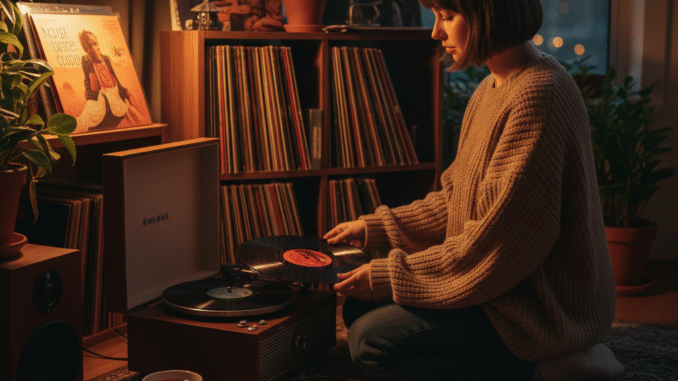
In an age dominated by instant access, digital streaming, and compressed audio files, the unexpected comeback of vinyl records stands as a curious anomaly. Once relegated to dusty attics and niche collector’s shops, vinyl has staged a remarkable resurgence, not just among nostalgic baby boomers but also a new generation of audiophiles, music lovers, and aesthetic enthusiasts. This isn’t merely a fleeting trend; it’s a profound shift for many who are seeking a more tangible, intentional, and often richer way to experience music. The reasons behind this analog renaissance are multifaceted, touching upon sound quality, ritual, aesthetics, and a deep-seated desire for a more connected engagement with art.
One of the most frequently cited reasons for vinyl’s appeal is its unique sound quality. While scientific debates about “absolute” fidelity between digital and analog rage on, many listeners perceive a warmth, depth, and richness in vinyl playback that they feel is absent in digital formats. This often comes down to the concept of the “analog warmth” – a subtle distortion and compression that some argue makes the sound more “natural” or “musical.” Digital audio, by its nature, samples sound waves and converts them into binary code. While incredibly precise, some purists believe this process can strip away certain nuances. Vinyl, on the other hand, captures the continuous sound wave as a physical groove, offering a different sonic experience. The crackle and hiss, often seen as imperfections, are paradoxically part of its charm for many, signaling an authentic, physical process rather than a sterile digital reproduction.
Beyond the purely auditory, the ritual of listening to vinyl plays a significant role in its allure. Streaming music involves a few taps on a screen, often leading to passive background listening. Vinyl demands participation. It begins with the act of selecting an album, removing it carefully from its sleeve, placing it on the turntable, cleaning the record, and gently dropping the needle. This deliberate process transforms music consumption from a casual activity into a mindful experience. It forces the listener to slow down, to engage fully with the music, and to appreciate it as a distinct event. This ritual can create a deeper emotional connection to the music, fostering a sense of occasion that digital formats often lack.
The tangibility and aesthetic appeal of vinyl are also undeniable drawcards. In a world increasingly saturated with ephemeral digital content, vinyl offers something solid and enduring. The large album art is a canvas in itself, designed to be admired and explored. Liner notes, lyrics, and credits, often overlooked in digital formats, are readily available, providing context and enhancing the overall artistic experience. Owning a physical record collection is a statement, a curated library that reflects one’s personality and musical journey. Displaying records can be an artistic expression, adding character to a living space. This physical connection to the music is deeply satisfying for collectors, providing a sense of ownership and permanence.
Furthermore, vinyl represents a powerful wave of nostalgia, particularly for older generations who grew up with records. For them, it’s a return to a beloved past, a rekindling of memories associated with specific albums, artists, and life moments. However, this nostalgia isn’t limited to those who experienced vinyl’s first heyday. Younger generations, growing up entirely with digital music, are discovering the “retro cool” of vinyl, drawn to its vintage charm and the distinct experience it offers compared to their usual consumption methods. For them, it’s a new form of exploration, a way to connect with music history and culture in a tangible way.
The collectibility aspect also fuels the vinyl boom. Limited editions, colored vinyl, picture discs, and rare pressings transform records into highly sought-after artifacts. The thrill of the hunt, discovering a rare gem in a used record store, or pre-ordering a special release, adds another layer of engagement for enthusiasts. This hobby fosters vibrant communities, both online and in physical record shops, where collectors share knowledge, trade, and celebrate their shared passion.
Finally, the shift back to vinyl can be seen as a rebellion against the perceived commodification of music in the streaming era. While streaming offers convenience, it often comes with lower artist compensation and an overwhelming amount of choice that can lead to “listening fatigue.” Buying a vinyl record is a more direct way to support artists and invest in their work. It signifies a conscious decision to value music as an art form worthy of a dedicated physical format, rather than just background noise in an endless digital stream.
In conclusion, the resurgence of vinyl is far more than a passing fad; it’s a cultural phenomenon driven by a confluence of factors: a perceived superior audio experience, a desire for mindful engagement, the undeniable aesthetic and tactile appeal of physical media, the power of nostalgia, and the joy of collecting. As listeners continue to seek deeper connections with their music, the humble vinyl record offers an authentic and enriching alternative to the digital deluge, proving that sometimes, the old ways are indeed the best ways to truly appreciate sound.

Leave a Reply